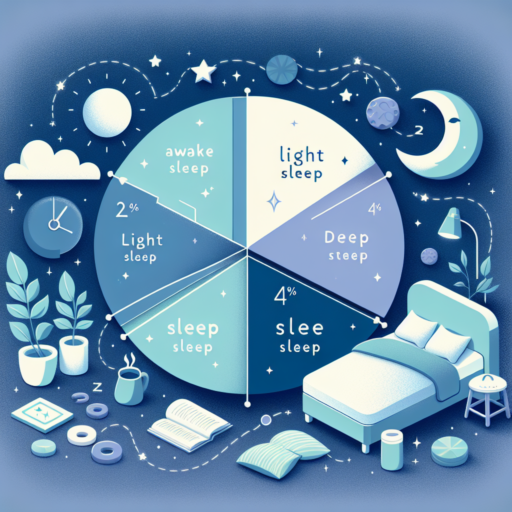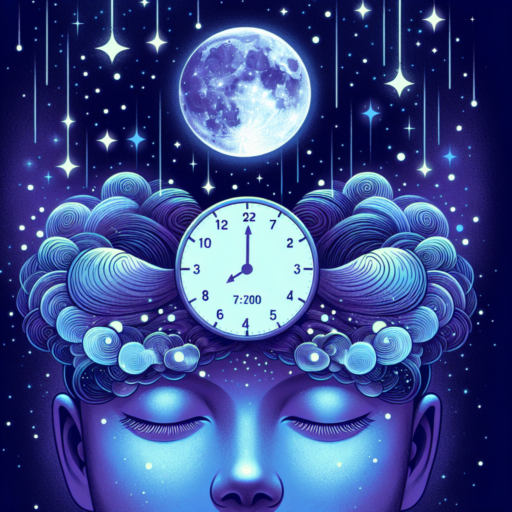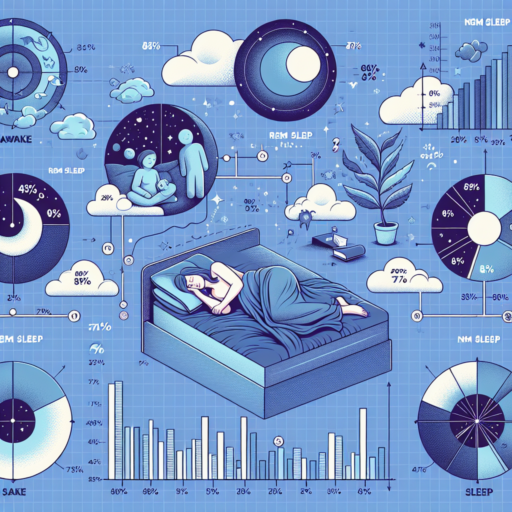No se han encontrado productos.
Understanding the Different Stages of Sleep
Sleep is a complex and essential part of our lives, impacting everything from our daily energy levels to long-term health. It’s not just about closing our eyes and drifting off; sleep is composed of several stages, each playing a critical role in restoring and rejuvenating our bodies and minds. By understanding the different stages of sleep, we can appreciate the complexity of what happens when we rest.
The NREM Sleep Stages
The first big chunk of sleep is encompassed by what’s called non-REM (NREM) sleep, and it’s divided into three distinct stages. The first stage is the transition from wakefulness to sleep, a light sleep where the person can be easily awakened. In this phase, which lasts for about 5 to 10 minutes, the body begins to slow down its functions, with heartbeat and breathing rates starting to decrease. The second stage of NREM sleep is where we spend the majority of our sleeping hours. During this stage, the body continues to relax, body temperature drops, and eye movements stop. This stage is critical for cognitive restoration and memory consolidation. The third and final stage of NREM sleep is the deepest, often referred to as «slow-wave» sleep. It’s during this stage that the body performs most of its healing and regeneration, strengthening the immune system and repairing tissues.
The REM Sleep Stage
Following the three stages of NREM sleep, the sleep cycle culminates in REM (Rapid Eye Movement) sleep. This stage is where dreaming occurs, facilitated by increased brain activity. Despite the brain’s heightened activity, the body remains in a state of paralysis, a phenomenon believed to prevent us from acting out our dreams. REM sleep is essential for emotional regulation and forming new learning and memory pathways in the brain.
Understanding the stages of sleep is crucial not only for health professionals but also for individuals looking to improve their sleep quality. Knowing which factors can disrupt the progression through these stages—such as stress, caffeine, and screen time before bed—can help in making informed decisions to enhance sleep.
How Much Sleep Do You Really Need?
Understanding the amount of sleep required is crucial for optimal health and well-being. The National Sleep Foundation provides recommended sleep durations according to age groups. Adults aged 18 to 64 typically need between 7 to 9 hours of sleep per night. However, the exact requirement can vary based on numerous factors such as lifestyle, health conditions, and stress levels.
It’s also important to consider the quality of sleep, not just the quantity. Achieving deep, uninterrupted sleep cycles plays a pivotal role in overall health. Factors like maintaining a regular sleep schedule, creating a comfortable sleep environment, and minimizing screen time before bed can significantly improve sleep quality.
Moreover, individual variations play a part in determining the ideal amount of sleep. Some people might feel refreshed and fully functional with 7 hours of sleep, while others may need a full 9 hours to perform at their best. Listening to your body and evaluating how you feel throughout the day can help determine if you’re getting adequate rest.
The Importance of Each Stage of Sleep
Understanding the importance of each stage of sleep is crucial for grasping how our bodies and minds recover, regenerate, and develop. From the light slumber when we first drift off, transitioning to the deeper phases where restoration occurs, each stage plays a unique role in enhancing our overall well-being.
Non-REM (NREM) Sleep: The Foundation of Rest
The journey through the stages of sleep begins with non-REM sleep, which can be broken down into three parts. The first stage is a transition from wakefulness into sleep and is known for its easy arousal. The second stage, where we spend approximately 50% of our sleep time, serves as a preparatory phase for deep sleep, marked by a decrease in heart rate and body temperature. The third and final stage of NREM is the deep sleep phase, essential for physical recovery, memory consolidation, and hormone regulation.
REM Sleep: The Dream Stage
Following the body’s procession through the stages of NREM sleep, we enter REM (Rapid Eye Movement) sleep, where the brain becomes almost as active as when we are awake. This stage is particularly known for vivid dreams and plays a vital role in emotional regulation, memory formation, and problem-solving skills. Interestingly, the length of each REM sleep period increases with each cycle, peaking just before we awaken, making it a critical component of feeling rested and alert for the following day.
Optimal Sleep Stage Durations for Health and Wellbeing
Understanding the optimal sleep stage durations is crucial for enhancing our health and wellbeing. Sleep is composed of several stages, each contributing uniquely to our physical and psychological recuperation. Navigating these stages in the right proportions is the key to waking up feeling refreshed and prepared to tackle the day ahead.
The first stage of sleep, light sleep, acts as a gateway between consciousness and sleep, playing a minimal role in our overall rest. However, it’s the transition into the deep sleep and Rapid Eye Movement (REM) stages that is most beneficial. Deep sleep is critical for physical recovery, memory consolidation, and hormonal regulation. It’s recommended to aim for a duration of 1-2 hours of deep sleep per night. On the other hand, the REM stage, where dreaming occurs, is pivotal for cognitive functions such as creativity, problem-solving, and emotional processing. Achieving approximately 1.5-2 hours of REM sleep nightly is ideal for most adults.
Striking the right balance between these stages ensures our bodies and minds receive the restorative benefits needed for optimal functioning. There’s no one-size-fits-all answer, as individual needs may vary, but understanding the significance of each stage and aiming for their recommended durations can significantly enhance one’s health and wellbeing.
How to Measure Your Sleep Stages
Understanding and measuring your sleep stages can play a crucial role in improving your overall sleep quality. In today’s tech-driven world, numerous tools and methods are available to help you track your sleep patterns, providing insight into the amount of time you spend in each sleep stage. Here, we’ll explore some of the most effective ways to measure these vital cycles.
Use of Wearable Sleep Trackers
Wearable sleep trackers are among the most popular tools for measuring sleep stages. These devices, often worn on the wrist, use sensors to monitor your heart rate, movements, and sometimes even your oxygen levels while you sleep. Many of these gadgets can differentiate between light sleep, deep sleep, and REM (Rapid Eye Movement) sleep, offering you a comprehensive view of your sleep cycle. Models vary in their accuracy, so it’s essential to choose a tracker that best fits your needs and preferences.
Smartphone Apps
Another accessible option for assessing your sleep stages is through smartphone apps. These applications typically work by analyzing your movements and sounds during sleep. While not as precise as wearable trackers, many people find them useful for getting a general idea of their sleep patterns. The key advantage of smartphone apps is their convenience and the absence of needing to wear anything extra to bed. However, for more detailed and accurate monitoring, combining them with a wearable device is advisable.
Professional Sleep Studies
If you’re looking for the most accurate measure of your sleep stages, a professional sleep study, or polysomnography, might be the route to take. Conducted in a sleep lab, these studies involve the use of extensive monitoring equipment to track your brain waves, heart rate, breathing, and movements over the course of a night. This method provides the most detailed data on your sleep stages, but its complexity and cost make it less accessible for routine tracking.
Tips for Achieving a Balanced Sleep Cycle
Maintaining a balanced sleep cycle is crucial for both physical and mental health. In a world where sleep is often compromised for productivity, finding the right balance can be challenging. However, with some strategic habits, it’s entirely possible to achieve a restful night’s sleep consistently. Here are some effective tips to help you on your journey.
Establish a Regular Sleep Schedule
One of the most effective steps you can take is to establish and stick to a regular sleep schedule. Going to bed and waking up at the same times each day, even on weekends, helps regulate your body’s internal clock. This consistency makes it easier to fall asleep and wake up naturally, reducing the chances of sleep disturbances.
Create a Pre-Sleep Routine
Developing a pre-sleep routine can significantly improve your ability to fall asleep. Engaging in relaxing activities such as reading a book, taking a warm bath, or practicing meditation can signal your body that it’s time to wind down. Avoid stimulating activities such as using electronic devices or exercising close to bedtime, as these can interfere with your ability to fall asleep.
Optimize Your Sleep Environment
Finally, ensuring your sleep environment is conducive to rest is key. This involves making your bedroom as comfortable and inviting as possible. Consider factors like the firmness of your mattress, the type of pillows you use, and the room temperature. Additionally, minimizing noise and light exposure can further enhance the quality of your sleep. Investing in blackout curtains or using a white noise machine are practical ways to achieve this.
Common Sleep Stage Myths Debunked
Many of us have heard varied theories and myths surrounding the stages of sleep. These myths often shape our perception of rest, affecting our sleep quality. By addressing and debunking the most common sleep stage myths, we aim to enhance everyone’s understanding of healthy sleep patterns.
Myth #1: You Don’t Dream in Non-REM Sleep
Contrary to popular belief, dreaming can occur in all stages of sleep, not just during rapid eye movement (REM) sleep. While it’s true that the most vivid and memorable dreams tend to occur during REM sleep, studies have shown that some dreaming occurs during non-REM stages as well, albeit less frequently and with less intensity.
Myth #2: The Longer You Sleep, the More Rested You Feel
It’s a common misconception that extending sleep duration guarantees more restfulness. However, quality trumps quantity when it comes to sleep. It’s more about cycling through the essential stages of sleep, including deep non-REM sleep, which is crucial for physical restoration, and REM sleep, important for cognitive functions like memory and learning.
How Lifestyle Choices Impact Sleep Stages
Understanding the dynamic between lifestyle choices and the impact on sleep stages is crucial for achieving restorative sleep. Each stage of sleep, including light sleep, deep sleep, and REM (Rapid Eye Movement) sleep, plays a pivotal role in our overall health and well-being. The choices we make during the day, from diet to exercise and stress management, can significantly influence the length and quality of these sleep stages.
Effect of Diet on Sleep
Nutritional choices can either promote or hinder the quality of our sleep stages. Consuming caffeine or high-sugar foods too close to bedtime can disrupt the natural progression through the sleep cycle, often leading to less time spent in deep sleep. On the other hand, foods rich in magnesium and tryptophan have been shown to support the journey into deeper, more restorative sleep stages.
Impact of Physical Activity
Regular physical activity is known to deepen sleep, making transitions between sleep stages smoother and more rhythmic. However, the timing of exercise can be just as crucial, as engaging in vigorous activity too close to bedtime may lead to heightened alertness, making it harder to fall asleep. Balancing the type and timing of exercise is key to harnessing its sleep-promoting benefits.
The interconnection between lifestyle choices and sleep stages emphasizes the importance of holistic health management. Paying attention to how our daytime activities, from what we eat to how we handle stress, can pave the way for a better night’s sleep, affecting every cycle of our rest. By fine-tuning these elements, we can foster a sleep environment that supports each crucial stage of sleep, leading to improved health and vitality.
Adjusting Your Sleep Schedule: Advice from Experts
Adjusting your sleep schedule is often necessary when you’re faced with life’s inevitable changes – be it due to a new job, travel, or merely a desire to improve your overall health and well-being. Experts in sleep science and circadian rhythms offer invaluable insights into making these adjustments effectively and sustainably. They emphasize the importance of understanding your body’s internal clock and gently coaxing it towards a new pattern, rather than attempting abrupt changes.
Gradual Adjustments Are Key
One crucial piece of advice from sleep experts is the importance of gradual adjustments. Abrupt changes to your sleep schedule can disrupt your circadian rhythm, making the transition more difficult and potentially leading to sleep disorders. Instead, shifting your sleep time in 15 to 30-minute increments every few days allows your body to adapt to the new schedule more comfortably, reducing the chances of sleep disruption.
Consistent Sleep and Wake Times
Maintaining consistency in your sleep and wake times is another essential strategy recommended by experts. Even on weekends or days off, sticking to your regular schedule reinforces your body’s sleep-wake cycle, making it easier to wake up and fall asleep at the desired times. This consistency aids in aligning your internal clock with your new schedule, thereby enhancing sleep quality and duration.
FAQs about Sleep Stages and Sleep Health
Understanding the different stages of sleep and their importance for overall sleep health is essential for maintaining a balanced and healthy lifestyle. Many commonly asked questions revolve around how these stages impact our well-being and what we can do to enhance our sleep quality.
What are the main stages of sleep?
Sleep is divided into two main types: REM (Rapid Eye Movement) and non-REM, which further includes three stages. Non-REM sleep begins with the transitional phase between wakefulness and sleep, progresses into light sleep where the body starts relaxing, and then moves into deep sleep, which is crucial for physical recovery and growth. REM sleep, often associated with vivid dreaming, plays a key role in emotional regulation and memory consolidation.
How do sleep stages affect my health?
Each stage of sleep serves a different purpose, contributing to brain function, mood regulation, and overall physical health. Lack of deep sleep, for instance, can impact your body’s ability to repair tissues and cells, while inadequate REM sleep might affect memory and emotional health. Ensuring a healthy balance between all sleep stages is key for achieving optimal health benefits from sleep.
Can improving sleep hygiene enhance sleep quality?
Absolutely. Good sleep hygiene practices, such as maintaining a consistent sleep schedule, creating a comfortable sleep environment, and avoiding stimulants before bedtime, can significantly improve the quality of your sleep. This, in turn, ensures that you cycle through all stages of sleep appropriately, enhancing both physical and mental well-being.




